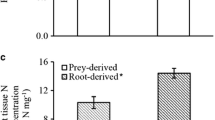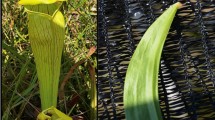Abstract
We have analysed the effect of prey and fertilization by inorganic nutrients on the survival, growth, reproduction (sexual and vegetative) and mucilage secretion of Pinguicula vallisneriifolia (Lentibulariaceae), a carnivorous plant inhabiting rocky substrates of southern Spain. We tested the hypothesis that carnivorous plants are more prey dependent when root access to nutrients is strongly limited by (1) analysing the importance of the carnivorous habit to the fitness of P. vallisneriifolia in its natural rocky habitat, and (2) determining whether the effect of trapped prey varies with soil nutrient levels. Our 2-year experimental results indicated prey to be limiting to P. vallisneriifolia growth on its natural rocky substrate. Animal food supply substantially increased the chance of survival, growth, vegetative propagation, sexual reproductive success and mucilage secretion. The differences between prey levels were more evident at the end of the experiment when all the surviving Prey-exclusion plants had lost weight, and the probability of sexual reproduction and of vegetative propagation by axillary buds had accordingly diminished. Furthermore, there were clear benefits from carnivory at the population level, since both the expected individual life span and the lifetime vegetative and sexual output correlated positively with the quantity of prey trapped. Application of insects to non-fertilized plants stimulated growth, but similar application to fertilized plants grown on a complete nutrient solution failed to enhance growth. There was no obvious benefit from the provision of a balanced mineral nutrient solution (alone or with prey). The greatest absolute growth and sexual and vegetative output resulted from providing a surplus of insects to plants on their natural rocky substrate. The strong dependence of P. vallisneriifolia on prey can therefore be considered a useful preadaptation enabling colonization of rocky substrates.
Similar content being viewed by others
Author information
Authors and Affiliations
Additional information
Received: 11 November 1996 / Accepted: 31 March 1997
Rights and permissions
About this article
Cite this article
Zamora, R., Gómez, J. & Hódar, J. Responses of a carnivorous plant to prey and inorganic nutrients in a Mediterranean environment. Oecologia 111, 443–451 (1997). https://doi.org/10.1007/s004420050257
Issue Date:
DOI: https://doi.org/10.1007/s004420050257




